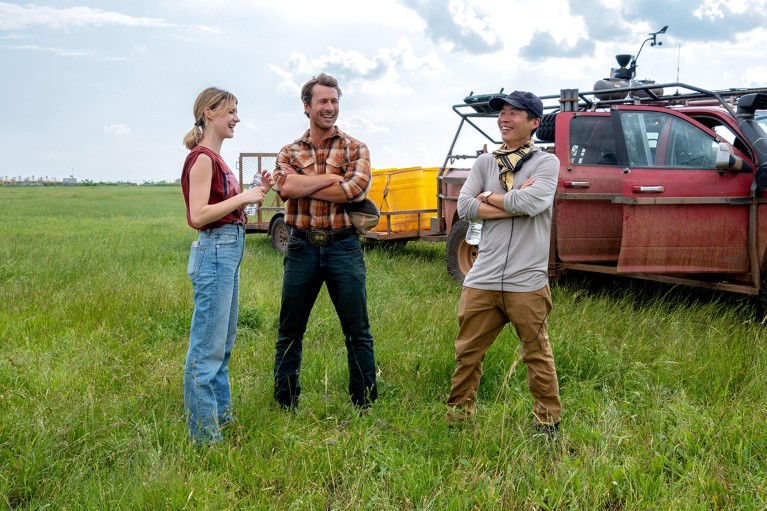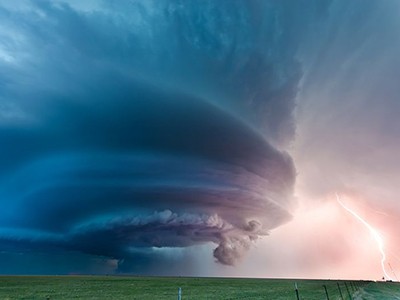What Twisters gets right — and wrong — about tornado science

When Hollywood producers showed up a few years ago at Sean Waugh’s office, he couldn’t wait to show them his thunderstorm-tracking equipment. Waugh, a meteorologist at the US National Severe Storms Laboratory in Norman, Oklahoma, is a big fan of the 1996 film Twister, which stars Helen Hunt and Bill Paxton as leaders of a tornado-chasing research team. And now, Hollywood was asking Waugh his opinion on how the science in the next film in the Twister franchise should look.
On 17 July, when the film is released internationally, the world will see how Waugh’s recommendations panned out. Like its predecessor, the new Twisters film focuses on characters who are storm chasers: Daisy Edgar-Jones plays a researcher traumatized by past weather disasters and Glen Powell a social-media star racing for footage of the biggest and baddest tornadoes. But science has an even bigger role in the plot of the new film than it had in the original, say Waugh and other researchers who worked as consultants for Twisters. It not only shows advanced radar data and highlights links between climate change and tornadoes, “it’s an incredible opportunity to inspire the next generation of scientists”, Waugh says.
Getting the science right
Meteorologists love to nitpick the original Twister film’s scientific errors. Although it drew inspiration from extreme-weather researchers at the Norman lab, it placed entertainment above scientific accuracy, scientists say. For instance, researchers often point sarcastically to scenes that used radar readings of clear skies, when audiences were supposed to be looking at data from a tornado’s swirling heart.
The new film is much more accurate, says Kevin Kelleher, a meteorologist who is retired from the Norman lab and consulted on both Twister films. For the 2024 version, “if they could change things and make it a bit more scientifically correct, they did”, he says. Kelleher credits that accuracy to the director of Twisters, Lee Isaac Chung, who has been fascinated by thunderstorms ever since growing up on a farm near the Oklahoma border.

Twisters stars Daisy Edgar-Jones (left) and Glen Powell (centre) chat with director Lee Isaac Chung in a field on set.Credit: Landmark Media/Alamy
Tornado science has come a long way since 1996, too — offering many chances to wow audiences. “The amount of data available is amazing now compared to 30 years ago,” Kelleher says. Today, the National Severe Storms Laboratory uses advanced scanning technologies known as phased array radar, which can be aimed precisely at developing storms, as well as sophisticated weather satellites that beam near-real-time conditions to forecasters. Twisters shows off these jaw-dropping observations, including scenes for which Waugh hand-picked data from famous real-life tornadoes to illustrate similar twisters on the big screen.
Other parts of the film take some dramatic licence. “You’ll obviously know when it departs from reality,” Kelleher says. For instance, one plot line explores weather modification, but instead of focusing on a real-world technique, such as the controversial practice of seeding clouds to boost rain- or snowfall, a character wants to test whether they can ‘collapse’ tornadoes with a fictional technology.
A focus on climate change
One area of science that researchers are glad to see included in the film is how global warming could be affecting tornadoes. Meteorologists don’t fully understand the effects of heat-trapping gases on twisters, but have documented behavioural changes in tornadoes over the past couple of decades. Compared with the 1960s, there are now fewer days in the United States with tornadoes, but there are more tornadoes each day when they do occur1. In the film, the characters come together as they chase particularly violent storm systems over Oklahoma.
Tornado scientists send drone fleet into violent thunderstorms
Tornadoes are now becoming more common farther south and east of the conventional ‘Tornado Alley’, which is thought as being centred on the US Great Plains2. This geographical expansion means that tornadoes are happening in hilly and forested landscapes, as well as at night, where it can be hard to see storms coming.
What makes the shift in where the tornadoes occur even more dangerous is that the southeastern United States has more people living in less resilient housing, such as mobile homes, which tornadoes can rip apart, than does the Great Plains3. “The alarming thing is that we’re seeing more tornadoes happen in areas that are incredibly vulnerable,” says Victor Gensini, an atmospheric scientist at Northern Illinois University in DeKalb.
Similar to the new film’s characters, scientists who chase storms sometimes see the destruction they cause up close. In May, a powerful tornado whipped through the town of Greenfield, Iowa, killing five people as two teams of atmospheric scientists gathered radar observations from a safe distance. The data showed wind speeds topping 300 miles an hour (500 kilometres an hour), making it one of the most intense tornadoes ever observed, says Karen Kosiba, an atmospheric scientist at the University of Illinois Urbana–Champaign. Even more terrifying is that those measurements were collected 30–50 metres above the ground; at the surface, where people and homes are, winds speeds are even faster4.
For storm chasers on the US Great Plains and elsewhere, Twisters is a chance to showcase their research to a much broader audience than usual. “This is the kind of thing I’m never going to shut up about for the rest of my life,” Waugh says.





